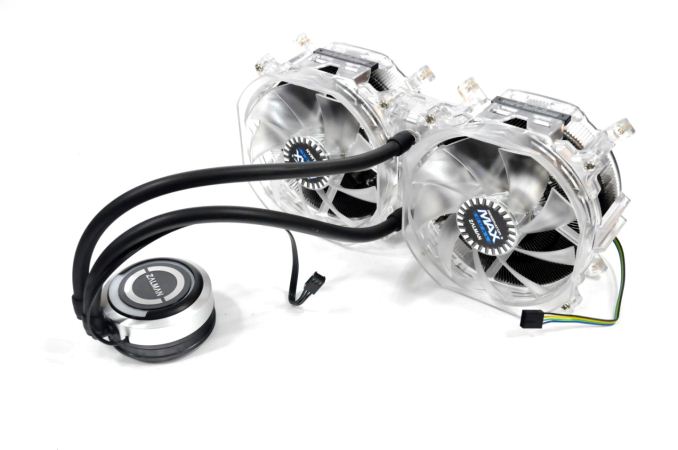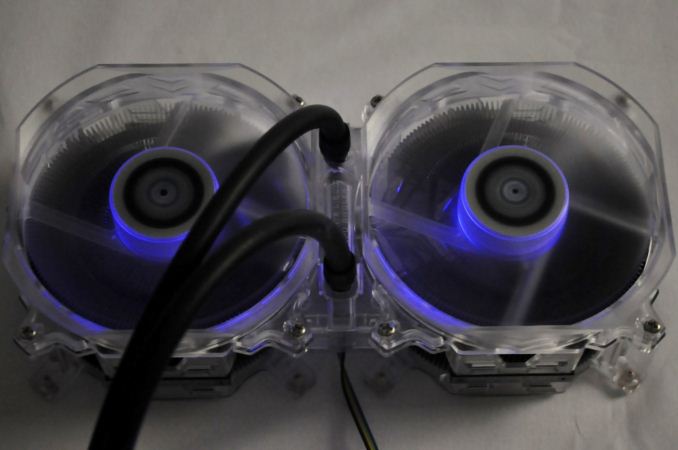Zalman Reserator 3 Max Dual CPU Cooler Review
by E. Fylladitakis on August 19, 2014 6:00 PM ESTConclusion
The Reserator 3 Max Dual is Zalman's trump card in the field of all-in-one liquid coolers and currently the most advanced such cooler that they offer. After they discontinued the Reserator 1 V2, it also is their most expensive liquid cooler, currently retailing for $140 incl. shipping at the time of this review. With the exception of the Enermax kits, which are unavailable in the US and importing them raises their cost dramatically, this makes the Reserator 3 Max Dual the most expensive all-in-one liquid cooler that we have tested to this date, regardless of size and features.
Zalman's Reserator 3 Max Dual certainly has a very long list of positive aspects. To begin with, it sports an impressive appearance that will easily stand out, without being extravagant or overly aggressive. It is very well made, using high quality materials and is free of imperfections. The PWM controlled fans are very handy to have, as their speed can be controlled by the motherboard, essentially emulating a typical CPU cooler and eliminating the need for external speed controllers and unnecessary cable clutter. If quality and appearance are what drives you, the Reserator 3 Max Dual will not be a disappointment.
On the other hand, the Reserator 3 Max Dual is far from flawless. The fancy-looking radiator is bulky and may easily create compatibility problems. Even with the supplied offset installation brackets, the case needs to be wide enough and you might lose a small portion of the radiator's area if the case does not have 140 mm fan openings. Moreover, although it sounds silly and unimportant, the decals on the sides of the radiator are upside down and that will look bad from a windowed side panel of a well-designed system. (Hopefully this is something that Zalman has fixed in their assembly process.) But ultimately, it's the performance of the Reserator 3 Max Dual cooler that confounds us the most.
Every all-in-one cooler that we have ever tested has a thermal resistance that either remains nearly constant or improves slightly as the load increases. Ideally, the thermal resistance of the cooler should be constant, but there are many factors at play in a complex multi-liquid system such as this. However, the thermal resistance of the Reserator 3 Max Dual increases alongside the load, which is inexplicable with what we know about this cooler.
Copper tends to have a thermal conductance that decreases faster than that of aluminum as the temperature rises, but the temperatures that we deal with are low and the change seems rather abrupt, therefore this is not very likely. Although we cannot fully explain why, it seems that the Reserator 3 Max Dual cannot dissipate high quantities of thermal energy quickly enough. This makes it the perfect cooler for the newest generation of processors but, at the same time, a bad idea for anyone who plans to use an energy-hungry CPU (e.g. extreme overclocking).
Our expectations were much higher from a product that is being advertised as the "ultimate CPU cooler". Assuming that the majority of enthusiasts that will buy such a cooling solution will also overclock their systems, we can only recommend the Reserator 3 Max Dual to those that will be using Haswell core processors, as they have very low energy requirements. If you expect the thermal power of your CPU to exceed 120 Watts when stressed, then another product will most likely be both cheaper and more effective.












52 Comments
View All Comments
bludragon - Wednesday, August 20, 2014 - link
So really what we need is testing using a real cpu since getting heat off the die is the biggest issue with Haswell and I assume the current AMD cpus. It would be good to see that with a stock cpu, and one that has been delidded and had the stock tim replaced with liquidpro. I expect most decent coolers will actually perform within a very similar and narrow range without the delid. I don't know what happens with the delid...garadante - Thursday, August 21, 2014 - link
Though I beg to pose the question that, if C/W is so important for someone reading these numbers, is it so unreasonable to assume that they may be seriously interested in using fans or thermal paste different from those included in the stock product? Which is one of my primary points in my comments. Testing CLCs 100% stock is useful for a certain segment of the audience but just that, a segment. Those users who care enough about performance to look into a CLC but not those who care enough to do the small extra steps necessary to eke even better performance out of an expensive piece of processor cooling equipment. I argue that the people who care about using better fans and better thermal paste are the same people who care about a radiator's C/W performance. And including a section of the review that looks at the performance of even a subset of these CLCs on actual CPUs would give a valuable contrast for the readers who don't realize the results here on useless in actual applications short of comparing radiators in a controlled environment. A section that says, "Hey, these are the best CLCs from the review but on this and that CPU at stock and such and such overclock the delta T is this. Therefore understand that you cannot use the results here to target a desired temperature for your own setup because there are so many variables. The results of this review simply allow you to choose a CLC based on its merits relative to other CLCs in a high controlled, synthetic environment. You might need research elsewhere if you're trying to hit 60 C Prime95 temperatures on your 4790K running at 4.7 GHz."AnnihilatorX - Thursday, August 21, 2014 - link
That's actually pretty easy to calculate base on C/W.4790k has maximum TDP of 88W, if a cooler has a C/W of 0.07, the cooler would be able to approximately cool the CPU to 6.16 deg C above ambient. You can see the numbers add up by comparing the different thermal watts in the graph "Core Temperature, Constant Thermal Load" and multiplying that with the respective C/W.
garadante - Thursday, August 21, 2014 - link
You fail to recognize my points. In the real world any of these CLCs with a C/W of 0.07 or even lower would be lucky to achieve a delta T of 40 with a 4970k at 4.7 GHz. Because there are many more factors involved regarding the temperature of a CPU core. Where the core is located relative to the best contact area between the heatsink and the IHS, what type of TIM is used between the die and the IHS, the IHS and the heatsink. These are things that can only be seen using an actual CPU which is my whole point. It seems that E.Fyll has tricked you into thinking his C/W numbers are at all meaningful in a real application. They serve one purpose and one purpose only: comparing the relative performance of CLCs. But that's easy enough to see just looking at the wattage temperature graphs. No use in making a function out of the results unless you want to know how a CLC would handle under a 1000 watt load on this specific testing rig.garadante - Thursday, August 21, 2014 - link
And testing with consistent fans across all radiators would give much more useful results when seeing the merits of each radiator. Fans are cheap and it's very reasonable to assume quite a few people would be interested in using aftermarket fans, -if- the performance gains are there, which is my whole point. The Cooler Master Nepton 280L looks good at first when you look solely at the temperature results, but then you look at the fan RPM and dB rating. The Corsair H110 uses a significantly slower and quieter fan but comes within a degree or two delta T of the 280L. Therefore Cooler Master likely uses very noisy, inefficient fans where Corsair uses much more efficient fans and quieter ones at that without sacrificing too much performance. Throw on the same fans on both and you remove that difference and you can see which radiator itself (where your money's going) actually is superior (or at least superior with higher CFM or higher static pressure or a mixture, etc, where E.Fyll coming up with an approximate function would actually be useful).BillyONeal - Wednesday, August 20, 2014 - link
Great article. It would be nice to see Noctua's NH-D14 or NH-D15 for a comparison with a good air cooler.bludragon - Wednesday, August 20, 2014 - link
I second thatC'DaleRider - Wednesday, August 20, 2014 - link
Here you go......(hint) It's in the Bench.http://www.anandtech.com/bench/CPUCooling/772
bludragon - Wednesday, August 20, 2014 - link
Thanks! I had forgotten about that. Only... looking at the results there the temps are not comparable to this article. Is there a post anywhere about the testing methodology for CPU coolers in bench? And yes, I did search...E.Fyll - Wednesday, August 20, 2014 - link
There will be many reviews of air coolers coming up. As they will be tested using the exact same procedure, the results will be directly compared to those of this review (and every cooling-related review that I perform).